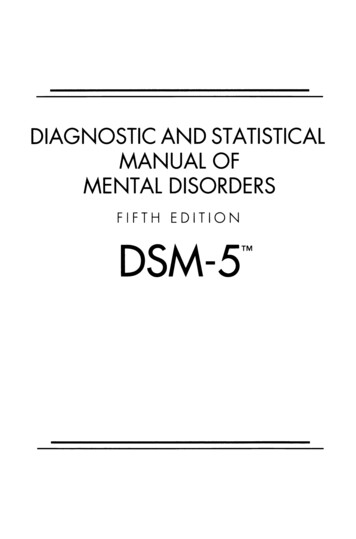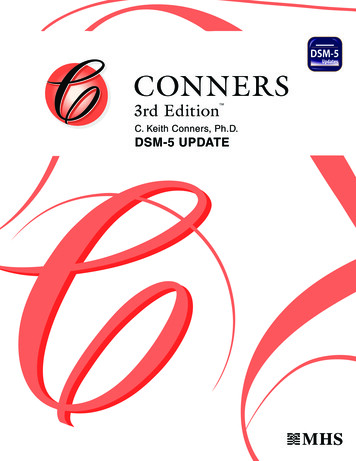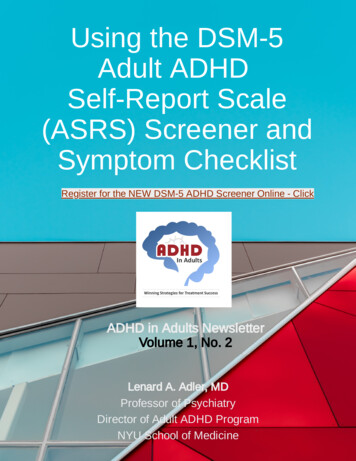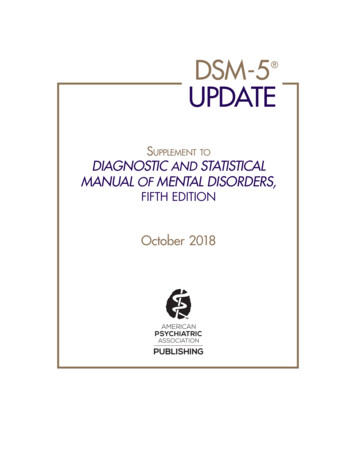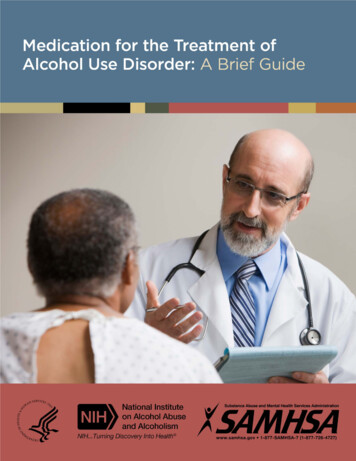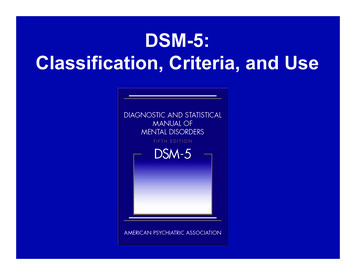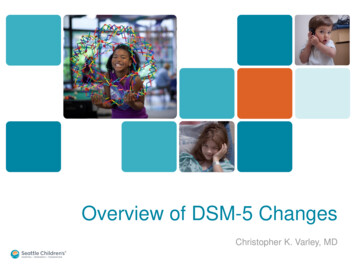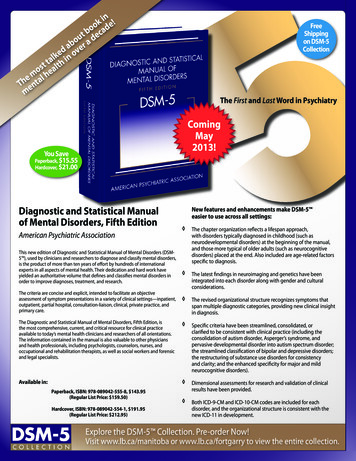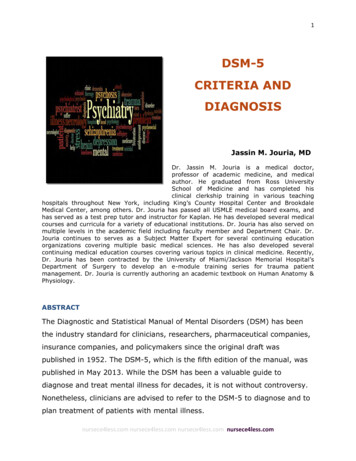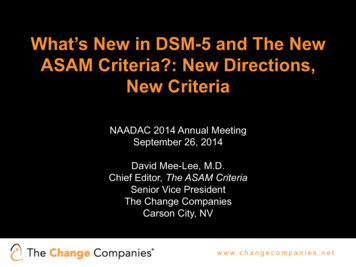
Transcription
What’s New in DSM-5 and The NewASAM Criteria?: New Directions,New CriteriaNAADAC 2014 Annual MeetingSeptember 26, 2014David Mee-Lee, M.D.Chief Editor, The ASAM CriteriaSenior Vice PresidentThe Change CompaniesCarson City, NVw w w. c h a n g e c o m p a n i e s . n e t
Select the Best Answer:1. In DSM-5:(a) The multiaxial system (Axes I-V) stays the same, butchanges to Axes 1-5 (Arabic numbers)(b) Substance Abuse and Substance Dependence mergeinto Substance Use Disorders (SUD) with legalproblems being a new criterion(c) Internet Disorder is a new diagnosis in the SubstanceRelated & Addictive Disorders chapter(d) All of the above(e) None of the abovew w w. c h a n g e c o m p a n i e s . n e t
Select the Best Answer:2. The best treatment system for addiction is:(a) A 28-day stay in inpatient rehabilitation with mucheducation(b) A broad continuum of care with all levels of careseparated to maintain group trust(c) Not possible now that managed care has placed somuch emphasis on cost-containment(d) A broad range of services designed to be asseamless as possible for continuity of care(e) Short stay inpatient hospitalization forpsychoeducationw w w. c h a n g e c o m p a n i e s . n e t
Select the Best Answer:3. What’s new in DSM-5 is:(a) New diagnoses of Cannabis Withdrawal & CaffeineWithdrawal; & Caffeine Use Dsiroder(b) A new criterion on craving in Substance Use Disorders(c) A new criterion on legal problems(d) Severity specifiers in SUD of mild, moderate, severeand chronic and extreme(e) None of the abovew w w. c h a n g e c o m p a n i e s . n e t
Select the Best Answer:4. The six assessment dimensions of ASAM Criteria:(a) Help assess the individual’s comprehensiveneeds in treatment(b) Provide a structure for assessing severity ofillness and level of function(c) Requires that there be access to medical andnursing personnel when necessary(d) Can help focus the treatment plan on the mostimportant priorities(e) All of the abovew w w. c h a n g e c o m p a n i e s . n e t
Select the Best Answer:5. A multidimensional assessment in behavioral healthtreatment:(a) Should include psychosocial factors such asreadiness to change(b) Is ideal, but not necessary within a managed careenvironment(c) Should include biomedical and psychiatric problems,but not motivation or relapse potential(d) Is best done after detoxification is completed(e) Should be completed by the primary therapist onlyw w w. c h a n g e c o m p a n i e s . n e t
Select the Best Answer:6. Assessment of a person’s goals & motivation isimportant to:(a) Match treatment to the client’s readiness to change(b) Ensure residential care is not wastefully utilized(c) Avoid confrontational approaches that alienate theclient(d) Individualize the referral and treatment plan(e) All of the abovew w w. c h a n g e c o m p a n i e s . n e t
Select the Best Answer:7. To ask a consumer what s/he really wants:(a) Is unnecessary as their judgment is poor(b) Is as important as assessing what the consumerneeds(c) Gives the false impression that they should havechoice about treatments(d) Leads to disrespect of the clinician’s authorityand expertise(e) Usually reveals unrealistic goals that should beignoredw w w. c h a n g e c o m p a n i e s . n e t
Select the Best Answer:8. The 2013 edition of The ASAM Criteria includes:(a) Changing all the Admission Criteria for all the levelsof care(b) New sections on sex and internet addiction(c) Adding sections on the application of Criteria to olderadults and parents with children(d) Changing the names of the six assessmentdimensions on The ASAM Criteriaw w w. c h a n g e c o m p a n i e s . n e t
Select the Best Answer:9. ASAM’s Definition of Addiction is incorporated in the newedition as follows:(a) It provides guidelines to have all addiction services beprovided by addiction physicians(b) It encourages all the levels of care to be used for chronicdisease management(c) It describes addiction as an acute illness that makesDimensions 1, 2 and 3 paramount(d) It requires all patients to have a chaplain involved for thespiritual aspects of treatmentw w w. c h a n g e c o m p a n i e s . n e t
Select the Best Answer:10. Changes in the new edition include:(a) Changing the designations of levels of care fromArabic numbers to Roman numerals(b) New sections on Gambling Disorder and TobaccoUse Disorder(c) Merging all the adolescent criteria into the adultcriteria(d) Adding an assessment dimension on spiritualityw w w. c h a n g e c o m p a n i e s . n e t
Select the Best Answer:11. In an era of healthcare reform:(a) The ASAM Criteria’s primary goal is to keepaddiction separate and safe from mental health.(b) Accountable care organizations and healthhomes will pay attention to addiction even less now(c) The ASAM Criteria can help integrate addictioninto general healthcare(d) None of the abovew w w. c h a n g e c o m p a n i e s . n e t
Select the Best Answer:12. The true spirit and content of The ASAM Criteriaensures that:(a) All withdrawal management occurs in amedically-monitored level to provide maximum safety(b) The length of stay is variable depending on theseverity of illness and the patient’s progress(c) The patient stays and graduates from each levelof care as determined by the primary counselor(d) Long-term residential treatment is alwaysnecessary if the client lives in a toxic environmentw w w. c h a n g e c o m p a n i e s . n e t
Select the Best Answer:13. The following terminology changes are made in TheASAM Criteria:(a) “Patient Placement” was removed in the booktitle, as the book no longer has placement criteria(b) Opioid Maintenance Therapy (OMT) was changedto Office-Based Opioid Treatment (OBOT)(c) Merging all the adolescent criteria into the adultcriteria(d) “Detoxification” changed to “WithdrawalManagement”. The liver detoxifies, but cliniciansmanage withdrawalw w w. c h a n g e c o m p a n i e s . n e t
Indicate True or False:TF14. It is not the severity or functioning thatdetermines the treatment plan, but thediagnosis, preferably in DSM terms15. Gambling Disorder is in DSM-5 and the newASAM Criteria16. There are six broad levels of care in the ASAMCriteria17. Dimension 5 focuses on internal attitudes,beliefs and coping skills to deal with relapsew w w. c h a n g e c o m p a n i e s . n e t
Indicate True or False:TF18. A diagnosis is necessary, but not sufficientto determine level of care19. The level of care placement is the firstdecision to make in the assessment20. Dimension 4, Readiness to Change, appliesonly to motivation for abstinence21. The Tobacco Use Disorder section encouragesall programs to become tobacco-freew w w. c h a n g e c o m p a n i e s . n e t
Indicate True or False:TF22. In criminal justice populations, it is importantto ensure patients “do treatment” not “do time”just focused on how long they have to stay23. The ASAM Criteria helps increase access tocare and use resources efficiently24. The co-occurring disorders section added a“complexity capable” description25. Clients in early stages of change needrelapse prevention strategiesw w w. c h a n g e c o m p a n i e s . n e t
DSM - Why Diagnostic Criteria? Need for classification of mental disorders has beenclear throughout history of medicine Little agreement on which disorders should beincluded; and optimal method for their organization Many nomenclatures (naming systems) have beendeveloped during past 2,000 years - differed in theirrelative emphasis on phenomenology, etiology, andcourse as defining featuresw w w. c h a n g e c o m p a n i e s . n e t
Why Diagnostic Criteria? (cont.) Some systems have included only handful of diagnosticcategories; others have included thousands Various systems for categorizing mental disorders havediffered with their principal objective for use in clinical,research, or statistical settings Creates a common language for communicationbetween clinicians about the diagnosis of disordersw w w. c h a n g e c o m p a n i e s . n e t
History of DSM 1952 – First edition. Since then DSM reviewed andrevised four times 1968 – DSM-II 1975 - Like DSM –I and DSM-II, development ofDSM-II was coordinated with development of ICD-9published in 1975 and implemented in 1978 1980 – DSM-III published after work had began onDSM-III in 1974 DSM-III introduced important methodologicalinnovations, including explicit diagnostic criteria,multiaxial system, and descriptive approach thatattempted to be neutral regarding theories of etiologyw w w. c h a n g e c o m p a n i e s . n e t
History of DSM (cont.) This effort was facilitated by extensive empirical workthen under way on construction and validation ofexplicit diagnostic criteria and development of semistructured interviews ICD-9 did not include diagnostic criteria or multiaxialsystem largely because primary function ofinternational system was to delineate categories tofacilitate collection of basic health statistics In contrast, DSM-III was developed with additionalgoals of providing medical nomenclature for cliniciansand researchersw w w. c h a n g e c o m p a n i e s . n e t
History of DSM (cont.) Experience with DSM-III revealed number ofinconsistencies in system and number of instances inwhich criteria were not entirely clear 1987 – Publication of DSM-III-R after APA appointedWork Group to revise and correct DSM-III 1994 – Publication of DSM-IV 2000 – Publication of DSM-IV- Text Revision 2013 – Publication of DSM-5w w w. c h a n g e c o m p a n i e s . n e t
Development and Use of DSM-IV andDSM-5 DSM-III represented major advance in diagnosis ofmental disorders and greatly facilitated empiricalresearch Development of DSM-IV benefited from substantialincrease in research on diagnosis that wasgenerated in part by DSM-III and DSM-III-Rw w w. c h a n g e c o m p a n i e s . n e t
Development and Use of DSM (cont.) Most diagnoses now have an empirical literature oravailable data sets relevant to decisions regardingrevision of diagnostic manual Task Force on DSM-IV and DSM-5 its Work Groupsconducted three-stage empirical process that included 1)comprehensive and systematic literature reviews, 2) reanalyses of already-collected data sets, and 3) extensiveissue-focused field trialsw w w. c h a n g e c o m p a n i e s . n e t
Definition of Mental Disorder – DSM-5 Syndrome characterized by clinically significant disturbance inindividual’s cognition, emotion regulation, or behavior Reflects dysfunction in psychological, biological, ordevelopmental processes underlying mental functioning Mental disorders usually associated with significant distress ordisability in social, occupational, or other important activities Expectable or culturally approved response to commonstressor or loss (death of a loved one) is not a mental disorderSocially deviant behavior (e.g., political, religious, or sexual)and conflicts primarily between individual and society are notmental disorders unless deviance or conflict results fromdysfunction in individual, as described above. w w w. c h a n g e c o m p a n i e s . n e t
Chapter Organization, Enhancements Lifespan approach – disorders diagnosed inchildhood e.g., neurodevelopmental disorders placed at beginning of manualand disorders more applicable to older adulthood e.g., neurocognitive disordersat endw w w. c h a n g e c o m p a n i e s . n e t
Dimensional Approach to Diagnosisnarrow Structural problems in previous DSM - large number of diagnostic categories in clinical practice, researchSubstantial use of “not otherwise specified” NOSdiagnoses -When full criteria not met, consider whether symptompresentation meets criteria for “other specified” e.g., “other specified depressive disorders,depressive episode with insufficient symptoms or “unspecified” designation Previous DSM - each diagnosis categorically separate from health and fromother diagnoses. Did not capturesharing of symptomsand risk factors across disorders (mood swings in bipolarand substance use disorders) heterogenousMost human ills, mental disorders- genetic riskfactors to symptoms e.g., 65 yo social drinker forced to retire versus 20 yowhose family history and role models point to heavy addiction at young agew w w. c h a n g e c o m p a n i e s . n e t
No More Multiaxial Systemnonaxial DSM-5 moved todocumentation of diagnosisMultiaxial distinction between Axis I, II and III did not implyfundamental differences - that mental disorders are unrelated tophysical and biological factors or processes, or that general medicalconditions unrelated to behavioral or psychosocial factors orprocesses In DSM-5 Axis IIIwith Axes I and II, with separatenotations for important psychosocial and contextual factors (formerlyAxis IV) and disability (formerly Axis V)Elimination of multiaxial diagnoses enhances a more combinedholistic and integrative systemw w w. c h a n g e c o m p a n i e s . n e t
Elements of a DiagnosisDiagnostic Criteria and Descriptors guidelines for makingdiagnoses, and use should be informed by clinicaljudgmentDiagnostic criteria offered asAfter assessment of diagnostic criteria, clinicians should considerapplication of disordersubtypes and/orspecifiers as appropriate Severity and course specifiers should be applied todenote individual’s current presentation, but only when full criteriametw w w. c h a n g e c o m p a n i e s . n e t
Elements of a DiagnosisDiagnostic Criteria and Descriptors severity (mild,moderate, severe, extreme), descriptive featuresWhere applicable, specific criteria for defining(with good to fair insight; in a controlled environment; andcourse (in partial remission, in full remission, recurrent)provided with each diagnosis Combination of: clinical interview, text descriptions,criteria, and clinical judgment – a diagnosisw w w. c h a n g e c o m p a n i e s . n e t
Elements of a DiagnosisSubtypes and Specifiers Subtypes and specifiers (some of which are coded in thefourth, fifth or sixth digit) provided for increasespecificity Subtypes define mutuallyexclusive and jointlyexhaustive phenomenological subgroupings withindiagnosis and indicated by instruction “Specify whether”in criteria set Specifiers are notintended to be mutuallyexclusive or jointly exhaustive, and as consequence,more than one specifier may be given.Specifiers indicated by instruction “Specify”or “Specifyw w w. c h a n g e c o m p a n i e s . n e tif” in criteria set
Elements of a DiagnosisSubtypes and Specifiers Specifiers provide an opportunity to define morehomogeneous subgrouping of individuals withdisorder who share certain features e.g., majordepressive disorder with mixed features Convey information relevant to management ofindividual’s disorder e.g., with other medical comorbidityspecifier in sleep-wake disorders currentpresentation. Previous diagnoses from whichDSM-5 diagnosis usually applied to individual’sindividual has recovered should clearly be noted as such e.g., specifiersindicating course e.g., in partial remission, in full remission may be listedafter the diagnosisw w w. c h a n g e c o m p a n i e s . n e t
Elements of a Diagnosis (con’t)Subtypes and Specifiers Where available, severity specifiers provided toguide clinicians in rating intensity, frequency, durationsymptom count, or other severity indicator of disorder.Indicated by instruction “Specify current severity” Descriptive features specifiers have also beenprovided in criteria set and convey additional informationthat can inform treatment planning e.g., obsessivecompulsive disorder, with poor insight Not all disorders include course, severity, and/ordescriptive features specifiersw w w. c h a n g e c o m p a n i e s . n e t
DSM-5 Substance-Related and AddictiveDisorders (Gambling Disorder) “dependence”– as label for addiction confusing; onlyfor physiological dependence Patients with normal tolerance and withdrawal labeled as “addicts.”,which is normal response to repeated doses of many medications (betablockers, antidepressants, opioids, anti-anxiety agents and other drugs) Tolerance and withdrawal symptoms not counted as symptoms fordiagnosis of substance use disorder when occurring in context ofappropriate medical treatment with prescribed medicationsw w w. c h a n g e c o m p a n i e s . n e t
DSM-5 Substance-Related and AddictiveDisorders (Gambling Disorder) Organized according to substanceversus according to diagnosis e.g., Hallucinogen Disorders vs SubstanceIntoxication or Substance Abuse or Dependence One criterion dropped, legalproblems because: (a) very low prevalence in adult and manyadolescent population samples; (b) low discrimination – legal problemsdoesn’t separate out distinctly who has SUD versus just social problems(developmental risk taking or antisocial personality, psychosis, mania andother mental health issues); (c) poor fit with other SUD criteria; (d) littleadded information in item response theory analyses. No patients hadlegal problems as their only criterion and none “lost” a DSM-5 SUD Dx.w w w. c h a n g e c o m p a n i e s . n e t
DSM-5 Substance-Related and AddictiveDisorders (Gambling Disorder) One criterion added, cravingbecause: (a) behavioral, imaging, pharmacology and genetic studiesindirectly support this criterion; (b) craving and its reduction can becentral to diagnosis and treatment; (c) craving is in ICD-10 dependencecriteria so this increases consistency between the nosologies; (d) fits wellwith other SUD criteria; (e) clinically useful AlsoInternet Gaming Disorder forSection III. Substance-Induced Dissociative Disorder removedw w w. c h a n g e c o m p a n i e s . n e t
DSM-5 Substance-Related and AddictiveDisorders (Gambling Disorder) Cannabis withdrawal and caffeinewithdrawal were both added. Tobacco Use Disorder aligned with criteria forother substance use disorders. New severity specifiers and updated remission specifiersw w w. c h a n g e c o m p a n i e s . n e t
Substance Use DisorderSubstance use disorder is defined by the followingcriteria in DSM-5:problematic pattern of substance useleading to clinically significant impairmentor distress as manifested by at least two ofthe following occurring in a 12-monthperiod:A. Aw w w. c h a n g e c o m p a n i e s . n e t
Substance Use DisorderSubstance use disorder is defined by the followingcriteria in DSM-5:A. A problematic pattern of substance use leading toclinically significant impairment or distress asmanifested by at least two of the following occurringin a 12-month period:1. Substance is often taken in larger amounts or over alonger period than was intended2. There is a persistent desire or unsuccessful efforts tocut down or control substance usew w w. c h a n g e c o m p a n i e s . n e t
Substance Use Disorder (cont.)3. A great deal of time is spent in activities necessary toobtain substance, use, or recover from the substance’seffects4. Craving or a strong desire or urge to use the substance5. Recurrent substance use resulting in a failure to fulfillmajor role obligations at work, school, or home6. Continued substance use despite having persistent orrecurrent social or interpersonal problems caused orexacerbated by the effects of the substancew w w. c h a n g e c o m p a n i e s . n e t
Substance Use Disorder (cont.)7. Important social, occupational, or recreationalactivities are given up or reduced because ofsubstance use8. Recurrent substance use in situations in which it isphysically hazardous9. Substance use is continued despite knowledge ofhaving a persistent or recurrent physical orpsychological problem that is likely to have beencaused or exacerbated by the substancew w w. c h a n g e c o m p a n i e s . n e t
Substance Use Disorder (cont.)10. Tolerance, as defined by either of the following:(a) a need for markedly increased amountsof substance to achieve intoxication or desired effect(b) markedly diminished effect with continued use ofthe same amount of the substance11. Withdrawal, as manifested by either of the following:(a) The characteristic withdrawal syndrome forsubstance(b) Substance is taken to relieve or avoid withdrawalsymptomsw w w. c h a n g e c o m p a n i e s . n e t
Severity and Course SpecifiersIn early remission: Full criteria for SUD were previously met None of the criteria for SUD have been met for atleast 3 months, but for less than 12 months Except for Criterion 4, “Craving or a strong desire orurge to use a specific substance”)In a sustained remission: Full criteria for SUD were previously met None of the criteria for SUD have been met at anytime during a period of 12 months or longer, Except for Criterion 4, “Craving or a strong desire orurge to use a specific substance”)w w w. c h a n g e c o m p a n i e s . n e t
Severity and Course Specifiers The following specifier applies as a further specifier ofremission (e.g. “early remission in a controlledenvironment”, and “sustained remission in acontrolled environment”) if the individual is inremission and in a controlled environment: In a Controlled Environment. This additionalspecifier is used if the individual is in an environmentwhere access to alcohol and controlled substances isrestricted. Examples of these environments areclosely supervised and substance-free jails,therapeutic communities, and locked hospital units.w w w. c h a n g e c o m p a n i e s . n e t
Severity Scale DSM-5The Severity of each Substance Use Disorder is basedon: 0 criteria or 1 criterion: No diagnosis2-3 criteria: Mild Substance Use Disorder4-5 criteria: Moderate Substance Use Disorder6 or more criteria: Severe Substance Use Disorderw w w. c h a n g e c o m p a n i e s . n e t
Example in DSM-5Alcohol-Related Disorders:305 Alcohol Use Disorder, severe303 Alcohol Intoxication with use disorder, severe291.81 Alcohol Withdrawal, with perceptualdisturbancesOther Alcohol-Induced Disorder291.9 Unspecified Alcohol-Related Disorderw w w. c h a n g e c o m p a n i e s . n e t
Recording Procedures for SUD Use the code that applies to the class of substancesbut record the name of the specific substance e.g.,record 304.10 (F13.20 – ICD-10) moderate alprazolam use disorder rather thanmoderate sedative, hypnotic, or anxiolytic usedisorder; or 305.70 (F15.10) mild methamphetamineuse disorder rather than mild stimulant use disorder.w w w. c h a n g e c o m p a n i e s . n e t
Co-Occurring and Substance-InducedMental Disorders SUD and mental disorders frequently co-occur - manysymptoms e.g., insomnia being criteria for intoxication,withdrawal syndrome, or other mental disorders DSM-IV: “primary” mental disorders if began prior tosubstance use or persisted than 4 weeks aftercessation of acute withdrawal or severe intoxication DSM-IV: Substance-induced mental disorders defined:occur during periods of substance intoxication orwithdrawal or remitting within 4 weeks thereafter; Sxsneed exceed expected severity of intoxication orwithdrawal; expected to remit within days to weeks ofabstinence – to improve poor reliability and validityw w w. c h a n g e c o m p a n i e s . n e t
Co-Occurring and Substance-InducedMental Disorders DSM-5 reversed these DSM-IV standardization criteriaand implemented flexible approach that lacked specificsymptom duration requirements and included additionof disorder-specific approaches:Criterion A: Disorder represents clinically significantsymptomatic presentation of relevant mental disorderw w w. c h a n g e c o m p a n i e s . n e t
Co-Occurring and Substance-InducedMental DisordersCriterion B: Evidence from history, physical exam, orlaboratory findings of both of following:1. The disorder developed during or within 1 month ofsubstance intoxication or withdrawal or taking amedication; and2. The involved substance/medication is capable ofproducing the mental disorder.w w w. c h a n g e c o m p a n i e s . n e t
Co-Occurring and Substance-InducedMental DisordersCriterion C: Disorder not better explained by independentmental disorder (i.e. one that is not substance-or medicationinduced). Such evidence of independent mental disordercould include following:1. Disorder preceded onset of severe intoxication orwithdrawal or exposure to the medication; or2. Full mental disorder persisted for substantial period oftime (e.g., at least 1 month) after cessation of acute withdrawalor severe intoxication or taking medication. Criterion doesnot apply to substance-induced neurocognitive orhallucinogen persisting perception disorders, which persistbeyond cessation of acute intoxication or withdrawalw w w. c h a n g e c o m p a n i e s . n e t
Co-Occurring and Substance-InducedMental DisordersCriterion D: The disorder does not occur exclusivelyduring the course of a deliriumCriterion E: The disorder causes clinically significantdistress or impairment in social, occupational, or otherimportant areas of functioning.w w w. c h a n g e c o m p a n i e s . n e t
DSM-5 Gambling DisorderPersistent and recurrent problematic gambling behavior leadingto clinically significant impairment or distress, as indicated byfour (or more) of the following in a 12-month period.1. Needs to gamble with increasing amounts of money in orderto achieve the desired excitement.2. Is restless or irritable when attempting to cut down or stopgambling.3. Has made repeated unsuccessful efforts to control, cutback, or stop gambling.4. Is often preoccupied with gambling (e.g., having persistentthoughts of reliving past gambling experiences,handicapping or planning the next venture, thinking of waysto get money with which to gamble).w w w. c h a n g e c o m p a n i e s . n e t
DSM-5 Gambling Disorder (cont.)5. Often gambles when feeling distressed (e.g.,helpless, guilty, anxious, depressed).6. After losing money gambling, often returns anotherday to get even (“chasing” one’s losses).7. Lies to conceal the extent of involvement withgambling.8. Has jeopardized or lost a significant relationship, job,or educational or career opportunity because ofgambling.9. Relies on others to provide money to relievedesperate financial situations caused by gambling.w w w. c h a n g e c o m p a n i e s . n e t
DSM-5 Gambling Disorder (cont.)B. The gambling behavior is not better accounted for by amanic episode.Course Specifiers Episodic Persistent In early remission In sustained remissionCurrent Severity:Mild: 4-5 criteria metModerate: 6-7 criteria metSevere: 8-9 criteria metw w w. c h a n g e c o m p a n i e s . n e t
Implications to Daily Work What is the role of diagnosis in your daily work? How do you talk to clients about their diagnosis andthe implications for their daily life Tracking diagnosis over time – past history andprevious episodes and service reviews Using rule-out diagnoses to consider differentialdiagnosesw w w. c h a n g e c o m p a n i e s . n e t
Generations of Clinical Care1. Complications-driven Treatmentw w w. c h a n g e c o m p a n i e s . n e t
Generations of Clinical Care2. Diagnosis-driven TreatmentRelapsew w w. c h a n g e c o m p a n i e s . n e t
Generations of Clinical Care3. Individualized, Clinically-driven Treatmentw w w. c h a n g e c o m p a n i e s . n e t
Generations of Clinical Care4. Client-directed, Outcome-informedw w w. c h a n g e c o m p a n i e s . n e t
Underlying Concepts (cont.)Multidimensional Assessment1. Acute Intoxication and/or Withdrawal Potential2. Biomedical conditions and complications3. Emotional/Behavioral/Cognitive conditions andcomplications4. Readiness to Change5. Relapse/Continued Use/Continued Problem potential6. Recovery Environmentw w w. c h a n g e c o m p a n i e s . n e t
Underlying Concepts (cont.)Treatment Matching - Modalities Motivate - Dimension 4Manage – All Six DimensionsMedication – Dimensions 1, 2, 3, 5Meetings – Dimensions 2, 3, 4, 5, 6Monitor- All Six Dimensionsw w w. c h a n g e c o m p a n i e s . n e t
Underlying Concepts (cont.)Treatment Levels of ServiceI à 1 Outpatient TreatmentII à 2 Intensive Outpatient and Partial HospitalizationIII à 3 Residential/Inpatient TreatmentIV à 4 Medically-Managed Intensive InpatientTreatmentw w w. c h a n g e c o m p a n i e s . n e t
Level 0.5 and OMTLevel 0.5: Early Intervention Services - Individualswith problems or risk factors related to substance use,but for whom an immediate Substance -Related Disordercannot be confirmedOpioid Maintenance Therapy (OMT) - Criteria for LevelI Outpatient OMT, but OMT in all levels à OpioidTreatment Program (OTP) with Opioid TreatmentServices (OTS) antagonist meds (naltrexone) andOffice-Based Opioid Treatment (OBOT) - buprenorphinew w w. c h a n g e c o m p a n i e s . n e t
Detoxification à WithdrawalManagement Services for Dimension 1I-D à 1-WM - Ambulatory WithdrawalManagement without Extended On-siteMonitoringII-D à 2-WM -Ambulatory WithdrawalManagement with Extended On-Site Monitoringw w w. c h a n g e c o m p a n i e s . n e t
Withdrawal Management Services forDimension 1 (continued)III.2-D à 3.2- WM- Clinically-ManagedResidential Withdrawal ManagementIII.7-D à 3.7- WM - Medically-Monitored InpatientWithdrawal ManagementIV-D à 4-WM - Medically-Managed InpatientWithdrawal Managementw w w. c h a n g e c o m p a n i e s . n e t
Level I and II à Level 1 and 2ServicesLevel I à 1Outpatient TreatmentLevel II.1 à 2.1 Intensive Outpatient TreatmentLevel II.5 à 2.5 Partial Hospitalizationw w w. c h a n g e c o m p a n i e s . n e t
Level III à Level 3 Residential/InpatientLevel III.1à 3.1- Clinically-Managed, LowIntensity Residential TreatmentLevel III.3 à 3.3- Clinically-Managed, MediumIntensity Residential Treatment à ClinicallyManaged Population-Specific High IntensityResidential Treatment(Adult Level only)w w w. c h a n g e c o m p a n i e s . n e t
Level III à Level 3 Residential/Inpatient (cont
Since then DSM reviewed and revised four times 1968 – DSM-II 1975 - Like DSM –I and DSM-II, development of DSM-II was coordinated with development of ICD-9 published in 1975 and implemented in 1978 1980 – DSM-III published after work had began on DSM-III in 1974
